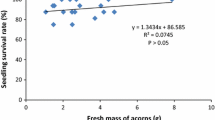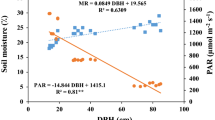Abstract
Oaks produce acorns containing a large amount of reserves in their cotyledons, which are important for the early development of seedlings. However, it remains unclear at what level oak seedlings will rely on cotyledonary reserves under different soil nutrition levels. We carried out an indoor experiment to quantify seedling growth, mobilization of cotyledonary reserves, and soil-derived N in seedlings of eleven red and white oak species in response to contrasting soil nutrition levels. Our results showed that dry masses of shoots, roots, whole seedlings, and the remnant cotyledons did not vary significantly in response to soil nutrition levels. Moreover, soil-derived N contents in oak seedlings were not significantly different under contrasting soil nutrition levels, reflecting a low morphological and physiological plasticity of oak seedlings to soil fertilization at early growth stage. Lower soil-derived N incorporated into seedlings suggests that oaks rely mainly on cotyledonary reserves for seedling development regardless of soil fertility. A positive correlation between mean fresh masses of acorns and mean dry masses of seedlings at the interspecific level further indicates that reserves in acorns rather than soil nutrition play an important role in supporting oak seedling growth at the early stage.






Similar content being viewed by others
References
Aerts R, Chapin FS III (2000) The mineral nutrition of wild plants revisited: a re-evaluation of processes and patterns. Adv Ecol Res 30:1–67
Andivia E, Fernández M, Vázquez-Piqué J, González-Pérez A, Tapias R (2010) Nutrients return from leaves and litterfall in a mediterranean cork oak (Quercus suber L.) forest in southwestern Spain. Eur J For Res 129:5–12
Bonfil C (1998) The effects of seed size, cotyledon reserves, and herbivory on seedling survival and growth in Quercus rugosa and Q. laurina (Fagaceae). Am J Bot 85:79–87
Dyckmans J, Flessa H (2001) Influence of tree internal N status on uptake and translocation of C and N in beech: a dual 13C and 15N labelling approach. Tree Physiol 21:395–401
Elwell AL, Gronwall DS, Miller ND, Spalding EP, Brooks TLD (2011) Separating parental environment from seed size effects on next generation growth and development in Arabidopsis. Plant Cell Environ 34:291–301
Frost I, Rydin H (1997) Effects of competition, grazing and cotyledon nutrient supply on growth of Quercus robur seedlings. Oikos 79:53–58
Guo CH, Simon J, Gasche R, Naumann PS, Bimüller C, Pena R, Polle A, Kögel-Knabner I, Zeller B, Rennenberg H, Dannenmann M (2013) Minor contribution of leaf litter to N nutrition of beech (Fagus sylvatica) seedlings in a mountainous beech forest of Southern Germany. Plant Soil 369:657–668
Hanley M, Fegan E (2007) Timing of cotyledon damage affects growth and flowering in mature plants. Plant Cell Environ 30:812–819
Hanley ME, May OC (2005) Cotyledon damage at the seedling stage affects growth and flowering potential in mature plants. New Phytol 169:243–250
Hanley M, Fenner M, Whibley H, Darvill B (2004) Early plant growth: identifying the end point of the seedling phase. New Phytol 163:61–66
Harper JL (1977) Population biology of plants. Academic Press, San Diego
Hou XG, Yi XF, Yang YQ, Liu WJ (2010) Acorn germination and seedling survival of Q. variabilis: effects of cotyledon excision. Ann For Sci 67:711
Jakobsson A, Eriksson O (2000) A comparative study of seed number, seed size, seedling size and recruitment in grassland plants. Oikos 88:494–502
Johnson PS, Shifley SR, Rogers R (2009) The ecology and silviculture of oaks, 2nd edn. CABI Publishing, Wallingford
Kennedy PG, Hausmann NJ, Wenk EH, Dawson TE (2004) The importance of seed reserves for seedling performance: an integrated approach using morphological, physiological, and stable isotope techniques. Oecologia 141:547–554
Kitajima K (2002) Do shade-tolerant tropical tree seedlings depend longer on seed reserves? Functional growth analysis of three Bignoniaceae species. Funct Ecol 16:433–444
Kobe RK (2006) Sapling growth as a function of light and landscape-level variation in soil water and foliar nitrogen in northern Michigan. Oecologia 147:119–133
Lahoreau G, Barot S, Gignoux J, Hoffmann WA, Setterfield SA, Williams PR (2006) Positive effect of seed size on seedling survival in fire-prone savannas of Australia, Brazil and West Africa. J Trop Ecol 22:719–722
Lehmeier C, Schäufele R, Schnyder H (2005) Allocation of reserve-derived and currently assimilated carbon and nitrogen in seedlings of Helianthus annuus under subambient and elevated CO2 growth conditions. New Phytol 168:613–621
Maillard P, Deléens E, Daudet FA, Lacointe A, Frossard JS (1994) Carbon and nitrogen partitioning in walnut seedlings during the acquisition of autotrophy through simultaneous 13CO2 and 15NO3 long-term labelling. J Exp Bot 45:203–210
Mancilla-Leytón JM, Cambrollé J, Vicente AM (2012) The impact of the common rabbit on cork oak regeneration in SW Spain. Plant Ecol 213:1503–1510
Mancilla-Leytón JM, Cambrollé J, Figueroa ME, Vicente AM (2013) Growth and survival of cork oak (Quercus suber) seedlings after simulated partial cotyledon consumption under different soil nutrient contents. Plant Soil 370:381–392
Meiners SJ, Handel SN (2000) Additive and non-additive effects of herbivory and competition on tree seedling mortality, growth, and allocation. Am J Bot 87:1821–1826
Milberg P, Lamont BB (1997) Seed/cotyledon size and nutrient content play a major role in early performance of species on nutrient-poor soils. New Phytol 137:665–672
Millard P, Neilsen GH (1989) The influence of nitrogen supply on the uptake and remobilization of stored N for the seasonal growth of apple trees. Ann Bot 63:301–309
Millard P, Proe MF (1991) Leaf demography and the seasonal internal cycling of nitrogen in sycamore (Acer pseudoplatanus L.) seedlings in relation to nitrogen supply. New Phytol 117:587–596
Newton AC, Pigott CD (1991) Mineral nutrition and mycorrhizal infection of seedling oak and birch. New Phytol 117:37–44
Nixon KC (1993) Infrageneric classification of Quercus (Fagaceae) and typification of sectional names. Ann Sci For 50:25s–34s
Oliet JA, Tejada M, Salifu KF, Collazos A, Jacobs DF (2009) Performance and nutrient dynamics of holm oak (Quercus ilex L.) seedlings in relation to nursery nutrient loading and post-transplant fertility. Eur J For Res 128:253–263
Perea R, Miguel AS, Gil L (2011) Leftovers in seed dispersal: ecological implications of partial seed consumption for oak regeneration. J Ecol 99:194–201
Schmal JL, Jacobs DF, O’Reilly C (2011) Nitrogen budgeting and quality of exponentially fertilized Quercus robur seedlings in Ireland. Eur J For Res 130:557–567
Shimada T, Saitoh T (2006) Re-evaluation of the relationship between rodent populations and acorn masting: a review from the aspect of nutrients and defensive chemicals in acorns. Popul Ecol 48:341–352
Silla F, Escudero A (2003) Uptake, demand and internal cycling of nitrogen in saplings of Mediterranean Quercus species. Oecologia 136:28–36
Silvertown J, Charlesworth D (2001) Introduction to plant population biology. Blackwell Science, Oxford
Sonesson LK (1994) Growth and survival after cotyledon removal in Quercus robur seedlings, grown in different natural soil types. Oikos 69:65–70
Stock W, Pate J, Delfs J (1990) Influence of seed size and quality on seedling development under low nutrient conditions in five Australian and south African members of the Proteaceae. J Ecol 78:1005–1020
Struve DK, Sternberg P, Drunasky N, Bresko K, Gonzalez R (2006) Growth and water use characteristics of six eastern North American oak (Quercus) species and the implications for urban forestry. Arboric Urban For 32:202–213
Tilki F (2010) Influence of acorn size and storage duration on moisture content, germination and survival of Quercus petraea (Mattuschka). J Environ Biol 31:325–328
Valladares F, Martínez-Ferri E, Balaguer L, Pérez-Corona E, Manrique E (2000) Low leaf-level response to light and nutrients in Mediterranean evergreen oaks: a conservative resource-use strategy? New Phytol 148:79–91
Villar-Salvador P, Planelles R, Enríquez E, Rubira PJ (2004) Nursery cultivation regimes, plant functional attributes, and field performance relationships in the Mediterranean oak Quercus ilex L. For Ecol Manage 196:257–266
Villar-Salvador P, Heredia N, Millard P (2010) Remobilization of acorn nitrogen for seedling growth in holm oak (Quercus ilex), cultivated with contrasting nutrient availability. Tree Physiol 30:257–263
Westoby M, Jurado E, Leishman M (1992) Comparative evolutionary ecology of seed size. Trends Ecol Evol l7:368–372
Westoby M, Leishman M, Jurado E (1996) Comparative ecology of seed size and dispersal. Philos Trans R Soc Lond B 351:1309–1318
Wolff JO (1996) Population fluctuations of mast eating rodents are correlated with production of acorns. J Mammal 77:850–856
Yang Y, Yi X (2012) Partial acorn consumption by small rodents: implication for regeneration of white oak, Quercus mongolica. Plant Ecol 213:197–205
Yi X, Liu C (2014) Retention of cotyledons is crucial for resprouting of clipped oak seedlings. Sci Rep 4:5145
Zhang S, Zhao C, Lamb EG (2011) Cotyledon damage affects seed number through final plant size in the annual grassland species Medicago lupulina. Ann Bot 107:437–442
Acknowledgments
This study was supported by the National Natural Science Foundation of China (No. 31470113), and the Program for New Century Excellent Talents in University (NCET-12-0693).
Author information
Authors and Affiliations
Corresponding author
Rights and permissions
About this article
Cite this article
Yi, X., Wang, Z. The Importance of Cotyledons for Early-Stage Oak Seedlings Under Different Nutrient Levels: A Multi-species Study. J Plant Growth Regul 35, 183–189 (2016). https://doi.org/10.1007/s00344-015-9516-7
Received:
Accepted:
Published:
Issue Date:
DOI: https://doi.org/10.1007/s00344-015-9516-7




